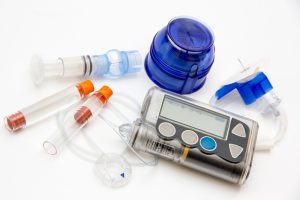New Pumps Offer Automated Glucose Monitoring, Insulin Dosing

"Smart" glucose monitoring and insulin-dosing technologies offered in the latest pump devices can improve quality of life for patients with type 1 and type 2 diabetes mellitus and may eliminate the hassles of frequent blood glucose monitoring.
In several new models, infusion sites attach to the skin with adhesive patches, housing cannulas to automate dosing based on continuous glucose sensor levels. Fewer injections and finger sticks are required, and display features have dramatically improved. Wireless signals can now connect to a patient’s mobile devices.
But endocrinologists and diabetes education experts caution that personal management and monitoring remain the most critical factors in diabetes health.
“The latest pumps can certainly offer improved quality of life for many patients,” says Nicole Jelesoff, MD, a Duke endocrinologist. “They can help smooth out some of the blood sugar peaks and valleys, but the technology does not eliminate the essential requirement that patients take and maintain responsibility for their diabetes care.”
Physicians and educators in Duke’s Division of Endocrinology, Metabolism, and Nutrition offer classes for patients with diabetes to explore the technologies. A certified diabetes educator (CDE) trains patients on pump operation, and manufacturer representatives are on hand to present the latest models.
“The ‘smart pumps’ have gotten smarter,” says Nancy Lelle-Michel, MSN, RN, coordinator of the Duke Adult Diabetes Education Program as well as a CDE. “They display the critical measures on readable screens, even on your mobile devices.”
Lelle-Michel promotes the convenience of the pumps, but she cautions that patients must still be vigilant. “They must take their bolus doses and maintain an off-pump plan,” she says, which is deployed if the pump fails or the patient wants to take a break from using the device.
When patients express interest in smart monitors and pumps, clinicians should consider the following characteristics as indications of likely benefit to patients:
- Frequent or severe hypoglycemia
- Low level of awareness regarding hypoglycemic conditions
- Need for small, precise doses
- Elevated glycated hemoglobin levels
- Dawn phenomenon (or dawn effect)
- Diabetic ketoacidosis
- Diabetes-related hospital stays or emergency department admissions
- Frequent travel through multiple time zones
- Unpredictable travel schedules
- Schedules or shifts that hamper dosing
Any patient considering pregnancy should receive counseling about pump options, Lelle-Michel says.